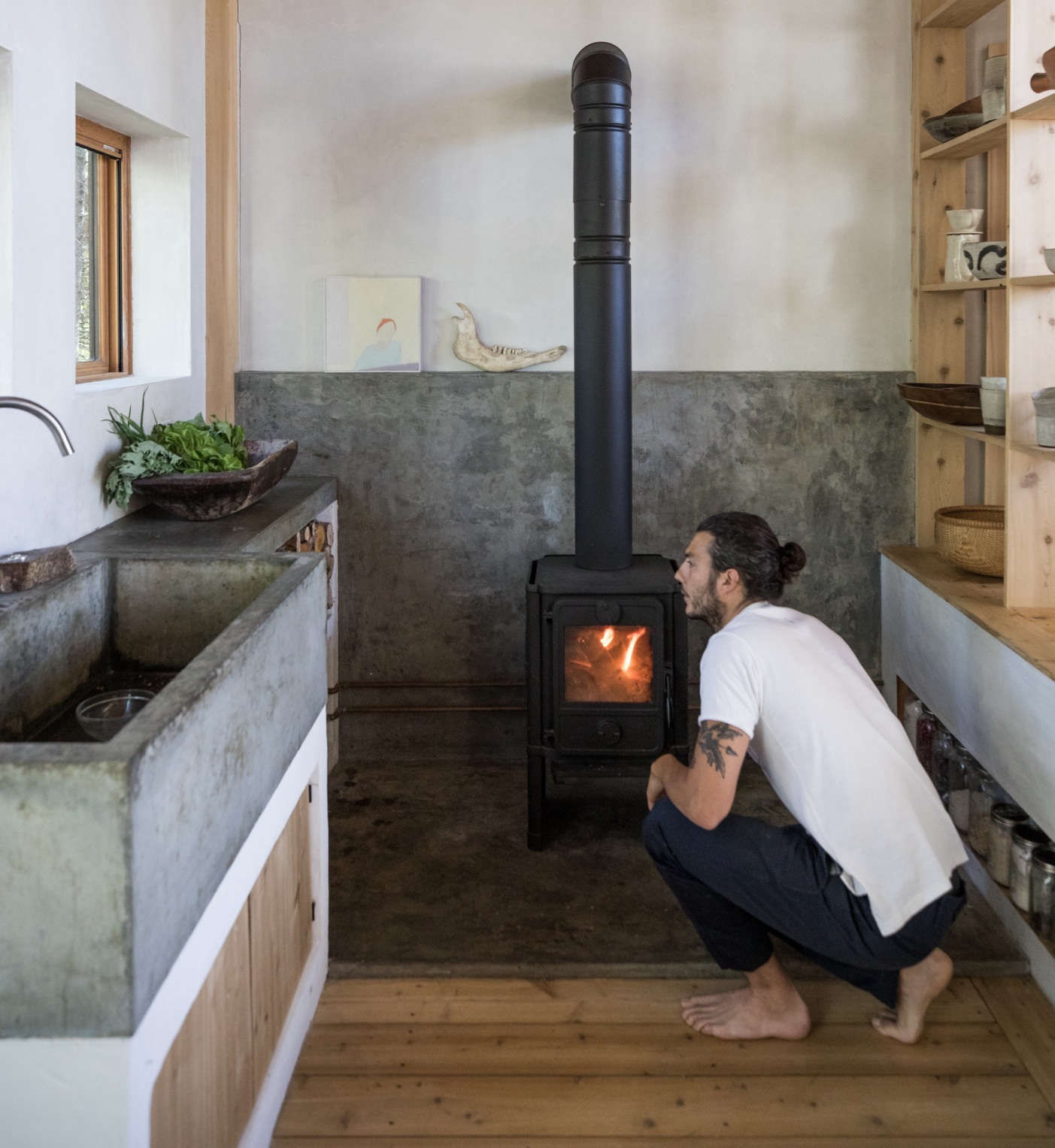
Concrete gets a bad rap: rough, clunky, cold, best suited for brutalist interiors. As it turns out, the concrete sink is coming into its own as one of the most versatile sinks we’ve seen, aesthetically.
An integrated concrete sink in the mostly concrete Casa Tiny, a Walden-Inspired Getaway in Mexico.
It makes a statement: The concrete sink takes an inexpensive material, formerly used only for construction and foundations, and turns it into something sculptural and bespoke.
Why would you want a concrete sink?
A poured-in-place concrete sink in the larder-like kitchen of a DIY home in Maine; see The Soot House: Conjuring the Ghosts of Old New England on Spruce Head in Maine.
Photograph by Greta Rybus.
You get to choose the size, shape, color, and surface texture, so you can have a sink that fits perfectly, size-wise, into your space and suits your home style-wise.
What are the advantages of a concrete sink?
And unlike most marble, granite, and engineered stone, which often has to be shipped from abroad, concrete is made of locally sourced material—gravel rock, sand, and cement—and thus has a smaller carbon footprint.
What are the disadvantages of a concrete sink?
Concrete has natural variations in color and texture that might irk those looking for a uniform look, and it will show wear—or, to use a more appealing expression, develop a patina.
But the main drawback, as Cheng points out, is that “no matter what you put in your concrete, it’ll never be as hard as granite or engineered stone. Concrete is more like limestone in terms of hardness.” That means it’s porous and must be treated to prevent staining and discoloration.
One of our all-time favorite projects, The Floating Farmhouse in Upstate New York, enlists a vintage, farmhouse-style concrete sink (and polished concrete floors).
Can you use a concrete sink in the kitchen?
“I’ve never recommended putting a concrete sink in a kitchen,” says Cheng. For those less tolerant of imperfection, however, the bathroom provides a gentler home for the concrete sink; there, it’s subjected to little more than tooth-brushing and face-washing.
What types of concrete sinks are available?
The great thing about concrete sinks is that, when customized, they can be made in whatever length, width, and depth you want.
A simple concrete sink in the Paris apartment of an architect and an artist; see At Home with an Artful Couple in the South of Paris for more.
What textures and colors are available?
The surface texture can range from smooth and polished to matte or rough-hewn.
“Some people will use white cement to create light pastel-y colors, but I prefer colors like those in nature, that aren’t too bright—and will stand the test of time. Your concrete will be in place for the long run.”
Photograph by Andria Lo.
A cast concrete sink looks almost delicate in an en suite bathroom at Manka’s Inverness Lodge, A 1900s Lodge Reborn in Northern California.
How do you care for a concrete sink?
Because concrete is porous, the surface must be sealed to protect it from stains and discoloration.
“It’s not bulletproof, but it gives you a surface that’s very restorable.” A newly installed sink may come with sealant already applied; ideally, the homeowner will maintain the finish by spritzing on a polishing agent or using a wax.
Concrete sink as sculpture: the sink in the bathroom of Casa Tiny in Oaxaca.
How much does a concrete sink cost?
Despite a relatively inexpensive material, concrete sinks are “not inexpensive,” Cheng warns. (For example, a small powder-room sink Cheng recently designed cost about $3,000 before installation.)
Are concrete sinks sold in stores?
True concrete sinks hard to find in stores and online, since they’re most often made custom, but companies such as Trueform Concrete and even Etsy shops such as CreatingConcrete offer ready-to-buy sinks in a variety of designs.
Photography by Carl Bellavia.
The concrete sinks and vanity are of a piece in Two Young Architects Tackle Their Own Brooklyn Townhouse.
It’s fine to mix and match your sink and countertop.
Does a concrete sink have to go with a concrete countertop?
But Cheng says his clients are often seduced by the idea of a sink made from the same material as the countertop: “An integrated concrete counter and sink always looks beautiful,” he says.
An idea to steal from An Urban Oyster Bar in NYC: a concrete sink paired with copper pipes.
When are concrete sinks cast on site?
Only in the case of a major project, says Cheng.
What special features are available?
Since these sinks are custom-made, you call the shots.
Cheng says you can contour the dimensions “any way that can be shaped in a mold.” That could mean different edge finishes, such as rolled or bullnose, as well as built-in features such as drainboards.
And, if you feel moved, concrete can also make a sculptural bath, as seen here in World’s Tiniest Spa Bath: A Grecian-Inspired Guest Suite in LA.
Photograph by Matthew Williams for Remodelista.
While books and online instructions for DIY concrete countertops abound, there’s not so much about making concrete sinks. But we think this might be one area best left to the pros.
Can I make my own concrete sink?